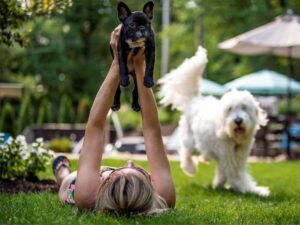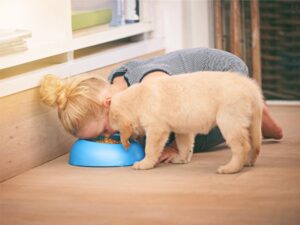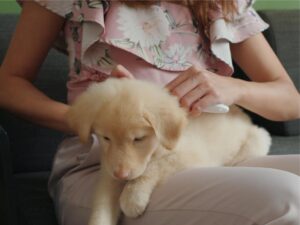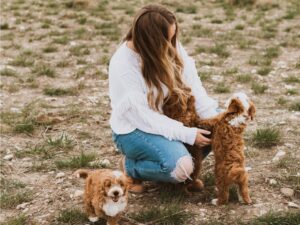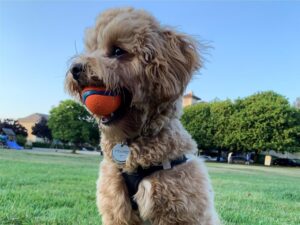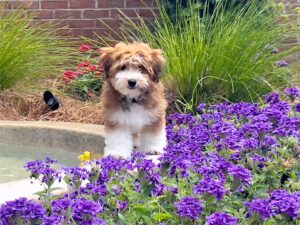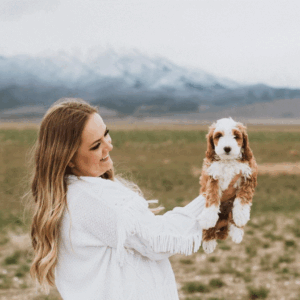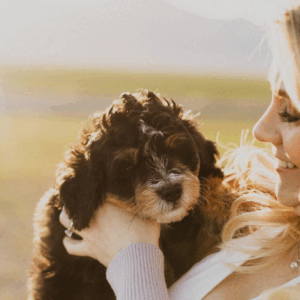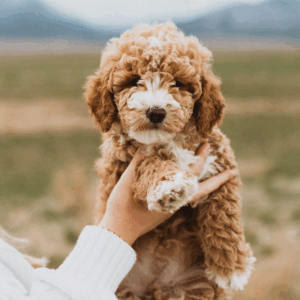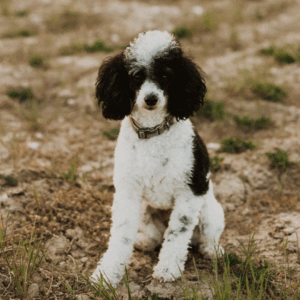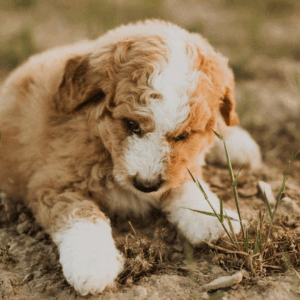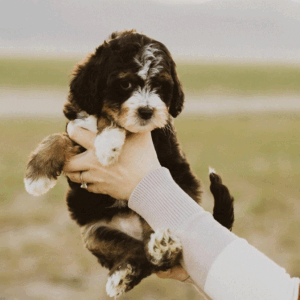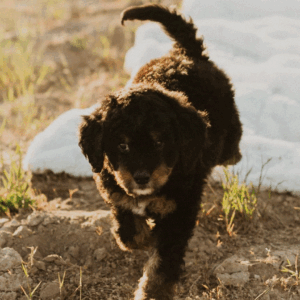Because the search for the perfect puppy requires the answers.
Do Havapoos
Shed A Lot?
Havapoos are a delightful and popular breed known for their charming personalities and lovable appearance. But if you're considering adding one to your family, you might wonder: Do Havapoos shed a lot? Let’s dive into everything you need to know about Havapoo shedding and grooming and why they’re such a low-shedding option for dog lovers!

Shedding and Allergies in Havapoos: What You Need to Know
Do Havapoos Shed?
Havapoos are considered low-shedding dogs, making them an excellent choice for families who prefer a cleaner home or individuals with mild allergies. Their minimal shedding is due to their unique coat type and genetic makeup:
- Curly or Wavy Coat – Thanks to their Poodle lineage, Havapoos have a curly or wavy coat that naturally traps loose hair instead of letting it spread around your home.
- Hypoallergenic Qualities – Their Havanese ancestry contributes a silky, low-shedding coat, enhancing their allergy-friendly nature.
Why Are Havapoos Low-Shedding?
The magic of the Havapoo’s coat lies in its parent breeds:
- Poodle Influence – Poodles are famously non-shedding and hypoallergenic, passing this trait to Havapoos.
- Havanese Influence – Havanese dogs have soft, silky coats that shed minimally, complementing the low-shedding qualities of the Poodle.
Proper grooming also plays a key role in keeping their shedding under control.
Grooming Tips to Minimize Shedding
A consistent grooming routine ensures your Havapoo’s coat remains healthy and tangle-free:
- Brush Regularly – Use a slicker brush designed for curly or wavy coats 3–4 times a week to remove loose hair and prevent matting.
- Bathe as Needed – A bath every 4–6 weeks with a gentle dog shampoo keeps their coat clean and soft without drying out their skin.
- Schedule Professional Grooming – Trimming their fur every 6–8 weeks helps maintain a manageable coat and prevent tangles.
- Detangle with Care – Use a detangling spray or conditioner to work through knots gently.
How Havapoos Compare to Other Breeds
Havapoos are often grouped with hypoallergenic breeds because they shed significantly less than many other dogs.
- Compared to Double-Coated Breeds – Breeds like Golden Retrievers and Huskies shed heavily, especially during seasonal coat changes, whereas Havapoos shed minimally year-round.
- Compared to Other Low-Shedding Breeds – Havapoos are similar to Poodles and Bichon Frises, both known for their low-shedding, allergy-friendly coats.
If you’re looking for a dog that won’t leave fur all over your furniture, Havapoos are a top contender!
Are Havapoos Good for Allergy Sufferers?
While no dog is entirely hypoallergenic, Havapoos are one of the best choices for people with mild allergies.
- Low Shedding = Less Fur in the Air – Their coat traps loose hair, reducing airborne allergens.
- Reduced Dander – Regular grooming helps remove dander, a common allergen, from their coat.
With consistent care, allergy sufferers can enjoy the companionship of a Havapoo without constant discomfort.
Understanding Allergies in Dogs: Why Your Havanese May Scratch and Chew Its Paws
If your Havanese or Havapoo frequently licks or chews its paws, allergies could be the culprit. Various factors, including food sensitivities, environmental triggers, and skin conditions, might contribute to this behavior.
Identifying Food Allergies in Dogs: Key Signs to Look Out For
Are you wondering if your dog might have a food allergy? Several signs can indicate that your furry friend is reacting to its diet. Recognizing these symptoms early can help you take the necessary steps to ensure their comfort and health.
Chewbacca’s Story: A Real-Life Example
Take Chewbacca, a lively retriever who suddenly developed a habit of incessant chewing. His owner was puzzled until they switched his diet to a new brand of dog food, and then the chewing stopped. This change highlighted a potential food allergy, emphasizing how specific ingredients in dog food can trigger such reactions.
Common Symptoms of Food Allergies:
Itchy Skin and Chewing:
- Dogs with food allergies often experience intense itching, prompting them to chew or scratch at their skin incessantly.
- Pay attention if your dog has suddenly increased chewing or licking of their paws, legs, or other body parts.
- As in Chewbacca’s case, a change in diet can sometimes alleviate these symptoms, suggesting a food allergy was the cause.
Gastrointestinal Issues:
- Frequent vomiting or diarrhea can be another indicator of food allergies.
- Note any changes in stool consistency or the frequency of these digestive disturbances.
Ear Infections:
- Recurring ear infections can be a common sign, especially if they persist despite treatment.
- Check for excessive ear scratching or an unusual odor.
Change in Coat Condition:
- A dull, lifeless coat or noticeable hair loss can hint at underlying allergies.
- Monitor any excessive shedding or bald patches.
Swelling and Redness:
- Some dogs may show signs of swelling, particularly around the face, paws, or other areas.
- Skin redness or rashes also correlate with allergic reactions.
Conclusion
In Chewbacca’s case, identifying and addressing the food allergy has led to a healthier, happier dog. By being aware of these signs, you can take proactive steps to ensure your pet’s well-being. Keep an eye on your furry friend for any of these symptoms and consult your vet if you suspect a food allergy. Your dog’s health and happiness are worth it!
- Why might it be important not to switch a dog’s food when they are healthy?
It is crucial to avoid changing a working diet to maintain the dog’s current state of health and prevent the reoccurrence of allergy symptoms.
- How can you tell if a dietary change effectively addresses food allergies?
The disappearance of symptoms such as chewing or scratching, which previously suggested an allergic reaction, can indicate an effective dietary change.
- What are the benefits of sticking with a diet that works for a dog with allergies?
Maintaining a diet that effectively addresses allergy symptoms ensures the dog remains healthy and comfortable, avoiding reintroducing allergens that could trigger reactions.
- What is an example of a successful dietary change for a dog with food allergies?
A successful dietary change can be seen when a specific brand of dog food alleviates symptoms like excessive chewing, which suggests a previously undetected food allergy.
How to Manage Food Allergies
- Try a Limited-Ingredient Diet – Switching to hypoallergenic or grain-free dog food may help reduce symptoms.
- Experiment with Novel Proteins – Foods with venison, duck, or hydrolyzed proteins can be less likely to trigger allergies.
- Add Omega-3 Supplements – These help improve skin health and reduce itching.
- Conduct a Dietary Trial – An elimination diet under a vet’s guidance can pinpoint specific food allergens.
Environmental Allergies in Dogs
Just like humans, dogs can be allergic to pollen, dust mites, or grass. Symptoms include:
- Seasonal Itching – If your dog’s symptoms flare up during specific times of the year, outdoor allergens might be the cause.
- Skin Irritations – Redness, rashes, or excessive scratching may indicate exposure to allergens.
How to Reduce Environmental Allergy Symptoms
- Regular Baths – Use hypoallergenic shampoos to remove allergens from your dog’s coat.
- Paw Care – Wipe your dog’s paws after outdoor walks to remove pollen or grass residue.
- Air Purifiers – Reducing indoor allergens can help alleviate symptoms.
Other Potential Causes of Paw Chewing
- Skin Conditions – Issues like eczema or dermatitis can cause irritation, leading to excessive licking or chewing.
- Parasites – Fleas, ticks, or mites can cause persistent itching. Ensure your dog is on a proper flea and tick prevention plan.
- Infections – Bacterial or yeast infections between the toes may require medicated treatment.
Solutions to Consider
- Consult Your Veterinarian – A vet can run tests to identify the underlying cause of allergies or skin irritation.
- Try Medicated Treatments – Antihistamines, steroids, or topical creams can help relieve itching.
- Use Moisturizers & Balms – Special paw balms or skin-soothing products can reduce irritation.
Final Thoughts: Why Havapoos Make a Great Choice
Havapoos are a dream for pet owners who want a loving, low-shedding companion. Their hypoallergenic coat makes them a great option for allergy sufferers, while their affectionate and playful personality makes them a joy to have around.
By maintaining a proper grooming routine and staying on top of potential allergies, you can ensure a happy, healthy life for your Havapoo—without the extra fur all over your home!
Yes, allergies can cause a dog to experience difficulty walking if they have been excessively licking or chewing their paws. Here's why:
Why Allergies Affect Walking
Irritation and Pain: When a dog suffers from allergies, their paws can become itchy and swollen. If the dog constantly licks or chews, this can lead to raw, sore spots on their paws.
Risk of Infection: Open wounds from excessive chewing are susceptible to infections. This can cause additional pain and inflammation, making it uncomfortable for the dog to move.
Reduced Mobility: The combination of irritation, pain, and possible infection can make walking challenging for the affected dog. They may limp or refuse to walk, trying to avoid discomfort.
What to Do Next
Consult a Veterinarian: If your dog is showing these symptoms, a veterinarian can help identify the triggers and recommend suitable treatments, such as antihistamines or special diets.
Protect the Paws: Consider using protective footwear or bandages to prevent further injury while healing takes place.
Implement Hypoallergenic Solutions: Opt for hypoallergenic shampoos or paw balms, which can soothe irritated skin and help manage symptoms.
Addressing the underlying cause of the allergies alongside direct treatment of the symptoms can help improve your dog's comfort and mobility.
Medications and Treatments
When it comes to treating your dog's allergies, you may wonder if over-the-counter medications are a safe option. Here's a closer look:
Antihistamines: Over-the-counter options, like Benadryl, can reduce itchiness, but always consult your vet first. This is crucial, as dosage and potential side effects can vary depending on your dog's size and health condition.
Zyrtec: Another antihistamine, Zyrtec, is also commonly considered for alleviating allergy symptoms in dogs. While many pet owners have found it effective, professional guidance is recommended to ensure it's suitable for your pet.
Expert Insights and Experiences
Numerous veterinarians have shared their insights on using these medications for dogs with allergies:
Common Issues: Dogs with allergies often exhibit symptoms like constant paw licking and chewing, which can lead to raw, irritated skin. These behaviors are frequently observed, particularly during certain seasons.
Veterinary Recommendations: Veterinarians often suggest trying antihistamines as a first step in managing mild allergic reactions. However, they emphasize the importance of a tailored approach, considering each dog's unique needs.
Case Studies: Many pet owners have successfully used these medications, with guidance from their vets, to manage their dogs' allergy symptoms effectively. Reports of satisfied outcomes highlight the potential benefits when used appropriately.
By combining expert advice with personal experiences, you can make an informed decision on whether over-the-counter allergy medications are the right choice for your furry friend. Always remember, consulting with your veterinarian is the best way to ensure your dog's safety and health.
If your dog has chewed its paw raw, it's essential to address both the symptoms and the underlying cause. Here’s a step-by-step approach to help your furry friend:
1. Consult a Veterinarian
Schedule an Appointment: First and foremost, visit your vet to rule out any serious health concerns. They can determine if the cause is an allergy, infection, or irritation.
Follow Recommendations: Your vet might recommend medication, such as antibiotics or antihistamines, to treat any infections or allergies.
2. Evaluate Diet
Consider Dietary Allergies: Dogs often react negatively to certain food ingredients. If your vet suspects a food allergy, they may suggest an elimination diet or a hypoallergenic food brand to identify and avoid triggers.
Switch Foods Carefully: Opt for high-quality dog food brands known for their balanced nutrition. Always transition between foods gradually over a week to prevent digestive upset.
3. Maintain Paw Hygiene
Regular Cleaning: Keep the affected area clean by gently washing it with a mild, dog-safe antiseptic solution. Avoid using harsh chemicals.
Apply Topical Treatments: Your vet might recommend a soothing ointment or cream to reduce inflammation and promote healing.
4. Prevent Further Chewing
Protective Gear: Invest in a protective bootie or wrap to shield the paw while it heals. This not only prevents further injury but can also deter licking.
Distraction Techniques: Engage your dog in playful activities to divert attention from the affected paw. Puzzle toys or chew toys can keep them occupied.
5. Monitor Progress
- Keep an Eye on Symptoms: Watch for improvements or signs of worsening. Persistent issues may require additional vet visits or a refined treatment approach.
By addressing both the immediate discomfort and the potential causes, you can help your dog recover and prevent future issues. Always consult professionals when in doubt, as they provide the most accurate and tailored advice for your pet's health.
When your furry friend starts obsessively licking and chewing their paws, it’s often a sign of underlying allergies or even a paw infection. Let’s explore the standard treatments to help soothe their discomfort and ensure they remain healthy and happy.
Identify the Allergen
- Food Allergies: Start with an elimination diet to pinpoint if specific ingredients trigger a reaction. Opt for hypoallergenic dog foods free from common allergens like beef, chicken, or grains. For instance, if your dog has stopped chewing excessively after switching foods, it might indicate a previous food allergy. Consistency with the right food can maintain their good health.
- Environmental Allergies: Pollen, mold, and dust mites can irritate your dog. Regular bathing with hypoallergenic shampoos can help remove allergens from their coat.
Dietary Adjustments
- Introduce novel protein sources like venison or duck to reduce allergic reactions.
- Omega-3 supplements can be beneficial as they have anti-inflammatory properties that help alleviate itching.
Medications and Treatments
- Antihistamines: Over-the-counter options, like Benadryl, can reduce itchiness, but always consult your vet first.
- Steroids: Prescribed for severe cases to quickly reduce inflammation and itching.
- Topical Treatments: Use anti-itch creams or sprays directly on affected areas to offer immediate relief. Look for products containing hydrocortisone.
Preventive Measures
- Keep your dog’s paws clean and dry, especially after outdoor walks.
- Regular grooming to keep their coat free of loose hair and irritants.
Consult Your Veterinarian
- Frequent or severe reactions warrant a consultation. Your veterinarian might suggest allergy testing or more advanced treatments such as immunotherapy.
By addressing the root cause and implementing these treatments, you’ll likely see a significant improvement in your dog’s comfort and overall health. If your dog has found relief and stopped chewing due to the right diet or treatment, it's crucial not to change what’s working well. Maintaining a consistent regimen ensures you don’t disrupt their newfound comfort and health.
How to Properly Wrap Your Dog's Paw to Ensure Protection
Wrapping your dog's paw can be crucial for protection and healing, whether it’s due to an injury or ailment. To do it effectively, follow these steps:
Gather Your Materials:
- Sterile gauze pads
- Non-stick wound pad (optional, if there’s an open wound)
- Adhesive bandage rolls (such as Vet Wrap)
- Medical tape or self-adhesive bandage
Clean Dry the Paw: Before wrapping, ensure that your dog's paw is clean and dry. This prevents infection and ensures that the bandage adheres properly.
Apply Padding: Place a sterile gauze pad or non-stick wound pad directly onto the affected area. This acts as a buffer and absorbs any moisture. If there's a wound, make sure the material is specifically designed to be non-stick to avoid aggravating the injury.
Wrap the Paw:
- Start wrapping from the toes and move upwards, slightly overlapping the layers.
- Aim for a snug but not too tight fit—this should maintain the paw's natural shape without compromising circulation.
- Keep checking for signs of discomfort, such as excessive licking or limping.
Secure the Bandage:
- Once the paw and lower leg are wrapped, use medical tape or a self-adhesive bandage to secure the wrap.
- Avoid wrapping too tightly. You should be able to insert one finger between the bandage and the paw.
Monitor Regularly:
- Check the bandage daily for moisture, dirt, or signs of loosening.
- Re-wrap as necessary and ensure that the paw remains clean and dry.
Importance of Proper Wrapping
Correct wrapping helps prevent further irritation, reduces the risk of infection, and provides support. Remember, the key is to strike a balance between providing adequate support and ensuring comfort.
If ever in doubt or if the injury seems severe, consult your veterinarian. They can provide guidance and even demonstrate the wrapping technique.
Is Dried Duck Food a Suitable Diet for Dogs with Allergies?
Dried duck food can indeed be a suitable option for dogs suffering from food allergies. Many pet owners have found that this type of diet is gentle on their dogs' digestive systems and effectively reduces allergy symptoms.
Why Choose Dried Duck Food?
Hypoallergenic Properties: Duck protein is often not included in regular dog foods, making it less likely to trigger allergic reactions in dogs sensitive to more common proteins like chicken or beef.
Nutrient-Rich: This type of food provides essential nutrients necessary for maintaining your dog's health without overwhelming their system with excessive richness.
Improved Health Indicators: Many dogs experience a reduction in allergy symptoms, such as excessive chewing or itching, when switched to a diet based on dried duck. This suggests that the allergy might have been triggered by their previous food choices.
What to Consider
Veterinary Consultation: Always consult with a veterinarian before making significant dietary changes to ensure it's the right fit for your dog's specific health needs.
Monitor Changes: After transitioning to a dried duck diet, closely observe any changes in your dog’s behavior and health to confirm it’s providing the desired benefits.
In summary, dried duck food can be a beneficial alternative for dogs with allergies, often alleviating symptoms while providing necessary nutrients to support overall health.
To determine if a diet is too rich for your dog, watch for signs that might indicate nutritional concerns. A diet that doesn't suit your dog can manifest through various symptoms, and being attentive to these cues is crucial for their well-being.
Key Indicators:
Digestive Issues: If your dog experiences diarrhea or vomiting, their diet might be too rich for their system.
Energy Levels: Overly rich foods can lead to hyperactivity or lethargy, disrupting your dog's normal energy balance.
Skin and Coat Health: Pay attention to any unusual itching, redness, or skin irritation. These could be signs of a food allergy or intolerance.
Weight Fluctuations: Rapid weight gain could indicate that the food is calorie-dense beyond their needs.
Monitoring and Adjusting
Consult a Vet: Regular veterinary check-ups can ensure that the diet meets your dog’s nutritional needs without being excessive.
Observe Eating Behavior: A sudden aversion or increased interest in food can be a clue to dietary imbalances.
By closely observing these factors, you can make more informed decisions about your dog’s diet and ensure it effectively supports its health.
Absolutely, a dog's disinterest in solo play could be a sign of boredom. When a pet has a plethora of toys yet chooses not to engage with them, it may suggest a need for more stimulation or companionship.
Understanding Dog Boredom
Lack of Stimulation: Dogs thrive on mental and physical challenges. If toys have become unexciting, it might be time to rotate them or introduce new types of playthings that stimulate their senses.
Exercise Needs: Regular physical exercise is crucial. Ensuring your dog gets plenty of playtime and outdoor activity can alleviate boredom.
Social Interaction: Dogs are social animals. They often prefer the company of their humans or other dogs. Taking your dog on walks or organizing playdates can satisfy this social need.
What's Next?
Consider taking your furry friend on outdoor adventures, engaging them with interactive toys, or even enrolling in a doggy daycare for added socialization. By doing so, you'll likely notice an improvement in their interest in solo activities as they get their fill of interactions and exercise.

You Have Questions,
We Have Answers!

Are You Ready
To Meet The Puppies...
Get ready for some serious cuteness overload! 🐾💕 Click here and meet your future best friend!
We're excited to assist you
Please, Reach Out Anytime!
Or if it's simpler for you...
Just share your info with us! We'll be in touch super fast - like a puppy bounding to greet you! 🐶✨
🐾✨
Extra tidbits
and wagging tails
of puppy wisdom!
What Is a Havapoo? The Adorably Smart Dog Everyone’s Falling…
Curious about Havapoos? Discover why this Havanese-Poodle mix is winning hearts everywhere with its adorable looks, intelligence, and loving personality.
How to Survive Your First Night With a Puppy 💤🐾…
Your first night with a new puppy doesn’t have to be ruff! 🐾 Discover expert tips from Lady Paws Puppies to make bedtime cozy, calm, and stress-free for both you and your furry friend.
🐶 Puppy Health Essentials: Vaccinations, Check-Ups, and More
Keeping your puppy healthy starts with vaccinations, vet check-ups, and preventive care. 🐶 Learn the essentials of puppy health to give your furry friend the best start in life!
🐶 Understanding Puppy Nutrition: What to Feed Your New Best…
Feeding your puppy the right way is essential for their growth! 🐶 Learn about balanced diets, feeding schedules, and the best puppy food to keep your furry friend healthy.
🐶 Grooming Tips for Your Furry Friend: Keeping Your Puppy…
Keep your puppy looking and feeling great! 🐶 This puppy grooming guide covers everything from bathing and brushing to nail trimming and ear cleaning for a healthy, happy pup.
🐶 How to Socialize Your Puppy: Creating a Happy Canine…
Socializing your puppy is key to raising a friendly, confident dog. 🐶 Learn expert tips to introduce your pup to new experiences, people, and animals the right way!
🐶 The Ultimate Puppy Care Checklist: From Feeding to Playtime
Bringing home a puppy? 🐶 Use this step-by-step puppy care checklist to ensure your new furry friend thrives! Covering feeding, training, health, and playtime essentials.
🐶 Preparing Your Home for a New Puppy: A Step-by-Step…
Getting a new puppy? 🐶 Ensure a safe and happy home with our step-by-step puppy-proofing checklist! Learn essential tips to make the transition smooth.
🐾 Puppy Training 101: Tips and Tricks for a Well-Behaved…
Bringing home a new puppy? 🐶 Get expert puppy training tips to teach obedience, stop bad habits, and build a strong bond with your furry friend!
Breed Spotlight: Havanese – The Charming, Cuddly Companion
The Havanese is a small, affectionate dog known for its playful personality and silky coat. Learn all about this charming companion, from fun facts to care tips!
Choosing the Perfect Puppy: A Comprehensive Guide for First-Time Pet…
Bringing home a puppy is an exciting journey! 🐶 But how do you choose the perfect one for your lifestyle? Our expert guide covers everything from breed selection to puppy care, ensuring a happy, lifelong bond.
🐶 What to Look for When Buying a Puppy Near…
Looking for puppies for sale near you? Learn how to find a healthy, well-bred puppy from a reputable breeder and avoid common mistakes. Your perfect pup awaits! 🐾
What Is the Best Age to Adopt a Cavapoo Puppy?
Curious about the best age to adopt a Cavapoo puppy? Learn why 8-12 weeks is ideal and how this timeline helps your puppy adjust and thrive in your home.
Are Havapoos Kid-Friendly? The Perfect Family Companion
Are Havapoos kid-friendly? Discover why this adorable and loving hybrid dog is the perfect companion for families with children. From their playful nature to their hypoallergenic coat, find out everything you need to know about Havapoos.
Do Cavapoos Adapt Well to Different Climates?
Cavapoos are known for their friendly nature and adaptability, but how do they fare in various climates? Discover how Cavapoos adjust to different weather conditions and what you can do to help them thrive.
Are Cavapoos Suitable for First-Time Dog Owners?
Cavapoos can be a great choice for first-time dog owners due to their friendly nature and trainability. Learn why these adorable dogs are perfect for new pet parents.
How Do I Prevent Cavapoo Health Issues?
Learn effective strategies to prevent common health issues in Cavapoos and ensure a long, healthy life for your furry friend.
What Are the Best Toys for Cavapoos?
Discover the best toys for Cavapoos that provide entertainment, mental stimulation, and exercise for your furry friend.
Are Cavapoos Prone to Health Issues?
Explore the potential health issues that Cavapoos may face and how to keep your furry friend healthy and happy.
How Do I Socialize My Cavapoo Puppy?
Learn how to properly socialize your Cavapoo puppy to ensure they grow into a well-mannered and confident dog. Tips and techniques included!
What Diet Is Best for Cavapoos?
Discover the best diet for Cavapoos to ensure their health and happiness. Learn about their nutritional needs, recommended foods, and feeding tips.
How Do I Train a Cavapoo Puppy?
Training a Cavapoo puppy requires patience, consistency, and positive reinforcement. Learn the best tips and techniques to raise a well-behaved Cavapoo.
Are Cavapoos Prone to Separation Anxiety?
Find out if Cavapoos are prone to separation anxiety, what causes this behavior, and tips to keep your Cavapoo calm and content when you're away.
Do Cavapoos Bark a Lot?
Discover whether Cavapoos are prone to excessive barking, what triggers this behavior, and how to encourage a calm and quiet Cavapoo.
How Often Should I Bathe My Cavapoo?
Discover how often you should bathe your Cavapoo to maintain a healthy coat and skin. Learn tips for bathing, grooming, and choosing the best products for your furry friend.
Are Cavapoos Suitable for Apartment Living?
Cavapoos are adaptable dogs known for their friendly and manageable temperament. Find out why they can be an excellent choice for apartment living and what to consider when raising a Cavapoo in a small space.
What Is the Temperament of a Cavapoo?
Cavapoos are renowned for their affectionate and adaptable temperament. Discover their personality traits, behavior around children and pets, and what makes them an ideal family companion.
What Colors Do Cavapoos Come In?
Cavapoos come in a wide range of stunning colors and patterns, making them a favorite for dog lovers. Learn about the most common Cavapoo coat colors and what makes them unique.
Do Cavapoos Get Along with Other Pets?
Cavapoos are known for their affectionate and adaptable nature, making them great companions for families with other pets. Learn how Cavapoos interact with cats, dogs, and other animals.
Are Cavapoos Good with Small Children?
Discover whether Cavapoos are good with small children. Learn about their temperament, behavior, and tips for creating a harmonious household.
How Much Exercise Does a Cavapoo Need?
Discover the exercise requirements for Cavapoos to ensure they remain healthy and happy. Learn how much activity these adorable dogs need daily.
What Makes Cavapoos So Popular?
Discover what makes Cavapoos one of the most sought-after dog breeds today, from their friendly nature to their adaptability as family pets.
Are Cavapoos Easy to Train?
Are Cavapoos easy to train? Learn about their intelligence, temperament, and tips to make training sessions successful and fun.
How Much Do Cavapoos Shed?
Wondering how much Cavapoos shed? Learn about their coat characteristics, shedding levels, and tips to keep their fur looking its best.
Do Cavapoos Require a Lot of Grooming?
Wondering if Cavapoos require a lot of grooming? Learn about their coat maintenance, grooming schedule, and tips to keep your Cavapoo looking its best.
Are Cavapoos Hypoallergenic?
Are Cavapoos hypoallergenic? Discover whether Cavapoos are suitable for allergy sufferers and tips for managing pet allergies.
What Is the Lifespan of a Cavapoo?
Curious about the lifespan of a Cavapoo? Learn how long Cavapoos typically live, factors affecting their longevity, and tips to keep them healthy.
How Big Do Cavapoos Get?
Curious about how big Cavapoos grow? Learn about their size, growth patterns, and what to expect for this popular designer breed.
Are Cavapoos Good Family Pets?
Cavapoos are known for their friendly and affectionate personalities. Discover why they make excellent family pets and what makes them so beloved.
What Are Cavapoos Known For?
Discover what Cavapoos are known for, from their friendly nature and intelligence to their adorable looks and suitability as family pets.
What Signs Indicate My Havapoo May Be Sick?
Recognizing the signs that your Havapoo may be sick is crucial for timely intervention. This post discusses common symptoms to watch for and when to consult a veterinarian.
Are Havapoos Prone to Seasonal Allergies?
Havapoos can be susceptible to seasonal allergies, which may affect their health and comfort. This post discusses the signs, causes, and management of seasonal allergies in Havapoos.
Do Havapoos Have Any Special Dietary Restrictions?
Havapoos may have unique dietary needs and restrictions. This post discusses the special dietary considerations for Havapoos to ensure they remain healthy and happy.
What is the Best Way to Manage a Havapoo’s Energy…
Havapoos are lively and playful dogs with varying energy levels. This post explores effective strategies to manage your Havapoo's energy to ensure a happy and healthy life.
Are Havapoos Prone to Ear Infections?
Due to their floppy ears, Havapoos can be prone to ear infections. This post discusses the causes, signs, and prevention tips for keeping your Havapoo's ears healthy.
How Can I Tell If My Havapoo Is Overweight?
Determining if your Havapoo is overweight is essential for their overall health. This post explores the signs, methods for assessing weight, and tips for maintaining a healthy weight.
Do Havapoos Have Sensitive Stomachs?
Havapoos can be prone to sensitive stomachs, which can lead to digestive issues. This post explores the causes, symptoms, and tips for managing your Havapoo's stomach sensitivities.
What is the Best Way to Prevent Havapoo Health Issues?
Preventing health issues in Havapoos is essential for their well-being. This post explores effective strategies and practices to keep your furry friend healthy and happy.
How Often Should Havapoos Visit the Vet?
Regular veterinary visits are essential for Havapoos to maintain their health and well-being. This post explores how often these adorable dogs should see the vet and why routine check-ups are crucial.
Are Havapoos Prone to Specific Health Problems?
Havapoos, a delightful mix of Havanese and Poodle, can be prone to certain health problems. In this post, we explore the specific health issues that may affect Havapoos and how to keep them healthy.
Do Havapoos Need Professional Grooming?
Havapoos have a unique coat that requires regular care. In this post, we explore whether professional grooming is necessary for Havapoos and what you can do at home to maintain their coat.
What Vaccinations Do Havapoos Need?
Vaccinations are crucial for keeping your Havapoo healthy and protected. In this post, we discuss the essential vaccinations every Havapoo needs for a happy and healthy life.
Can Havapoos Adapt to Apartment Living?
Havapoos are known for their friendly and adaptable nature. But can they thrive in an apartment setting? In this post, we explore the characteristics that make Havapoos suitable for apartment living.
How Much Exercise Do Havapoos Need?
Find out how much exercise your Havapoo needs to stay healthy and happy. Learn about ideal activities, daily routines, and tips to keep your furry friend active.
What Type of Diet Is Best for a Havapoo?
Discover the best type of diet for your Havapoo to ensure their health and happiness. Learn about nutritional needs, feeding schedules, and tips for selecting the right food.
How Often Should I Bathe My Havapoo?
Learn how often you should bathe your Havapoo to keep their coat and skin healthy. Discover tips on maintaining their hygiene while avoiding common grooming mistakes.
Are Havapoos Prone to Dental Issues?
Learn if Havapoos are prone to dental issues and discover the best ways to care for your furry friend’s oral health. Keep their teeth clean and healthy!
How Do You Care for a Havapoo’s Coat?
Learn how to care for a Havapoo's coat with this essential guide. From brushing to bathing, keep your Havapoo's coat healthy and beautiful.
Do Havapoos Shed a Lot?
Wondering if Havapoos shed a lot? Discover the low-shedding nature of Havapoos, why they are hypoallergenic, and how to care for their beautiful coats.
How Often Do Havapoos Need Grooming?
Wondering how often your Havapoo needs grooming? Learn the recommended schedule, tips for maintenance, and how to keep your Havapoo looking their best.
Do Havapoos Have Separation Anxiety?
Explore whether Havapoos are prone to separation anxiety and learn how to manage it effectively for your furry friend.
Are Havapoos Friendly with Strangers?
Discover whether Havapoos are friendly with strangers and learn about their social behavior and tendencies.
How Do Havapoos Behave When Left Alone?
Discover how Havapoos handle being left alone, their behavior patterns, and tips for easing separation anxiety.
Are Havapoos Protective or Territorial?
Wondering if Havapoos are protective or territorial? This post explores their instincts and behavior to help you understand these lovable dogs better.
Do Havapoos Bark a Lot?
Are you considering a Havapoo and wondering about their barking tendencies? This post explores whether Havapoos bark a lot and what factors influence their vocal behavior.
Are Havapoos Suitable for First-Time Dog Owners?
If you're a first-time dog owner, you might wonder if a Havapoo is the right breed for you. This post explores the characteristics and needs of Havapoos to help you decide if they are a suitable choice for your family.
Are Havapoos Easy to Train?
Are you considering bringing a Havapoo into your home but unsure about their trainability? This post explores whether Havapoos are easy to train and offers tips for effective training methods.
Do Havapoos Get Along with Other Pets?
Wondering if Havapoos can coexist with other pets? This post explores their social nature and offers tips for ensuring a smooth introduction to your furry family members.
Are Havapoos Good with Children?
Find out if Havapoos are good with children! This post explores their temperament, behavior, and why they make great family pets.
What Is the Personality of a Havapoo Like?
Learn about the charming personality traits of Havapoos, from their affectionate nature to their playful behavior. Discover what makes them such delightful companions.
What Is the Difference Between a Havapoo and a Cavapoo?
Discover the differences between Havapoos and Cavapoos, two popular designer dog breeds. Learn about their traits, temperaments, and care needs.
Are Havapoos Recognized by the American Kennel Club (AKC)?
Wondering if Havapoos are recognized by the AKC? Discover the status of this popular breed and what it means for owners and breeders.
What Coat Colors Are Common in Havapoos?
Curious about the coat colors of Havapoos? Discover the most common colors and patterns that make these adorable dogs stand out.
Are Havapoos Hypoallergenic?
Wondering if Havapoos are hypoallergenic? Learn about their coat, shedding, and whether they’re suitable for allergy sufferers.
What Is the Average Lifespan of a Havapoo?
Wondering how long Havapoos live? Learn about the average lifespan of this charming breed and the factors that can influence their longevity.
How Big Do Havapoos Get? Understanding Their Size and Growth
Curious about Havapoo size? Learn how big Havapoos get, including their weight and height, plus tips on growth and care for this hybrid breed.
What Breeds Make Up a Havapoo? Discover the Parent Breeds
Curious about what breeds make up a Havapoo? Discover the mix of Havanese and Poodle that creates this lovable, hypoallergenic companion.
Are Havapoos purebred dogs?
Curious if Havapoos are purebred dogs? Learn about their unique mix, traits, and why they make such lovable companions.
Puppy Delivery Services – Lady Paws Puppies
Learn about our convenient puppy delivery options at Lady Paws Puppies, including national delivery with a puppy nanny or pickup from Salt Lake City, Utah.
What to Consider Regarding a Dog’s Potential for Playfulness: Factors…
When choosing a dog, it’s important to consider their potential for playfulness. Here’s what you need to know about how playfulness impacts your dog's behavior, energy needs, and relationship with you.
Training Tips for Dogs Living in Apartments: Best Practices for…
Living in an apartment with a dog requires some adjustments when it comes to training. Here are some tips to help your dog thrive in a small space and make apartment life more comfortable for both of you.
How to Determine if a Dog Breed is Suitable for…
Choosing the right dog breed for your lifestyle is essential for a happy, harmonious relationship. Here’s how to assess a breed’s temperament, exercise needs, and compatibility with your home environment.
How Can You Determine if a Dog Is Good with…
Wondering if a dog is good with kids? Learn how to identify the signs that indicate a dog’s temperament is suited for living with children, including their behavior, body language, and interactions with young family members.
How Can You Determine if a Dog Is Friendly Toward…
Identifying whether a dog is friendly toward other dogs involves observing their body language, behavior during interactions, and their social experiences. Learn how to recognize the signs of a dog that is comfortable and friendly with other dogs.
What Are the Traits of a Dog That Is Friendly…
A dog’s friendliness toward strangers is a reflection of its socialization and temperament. Learn the key traits that make a dog friendly, approachable, and confident in meeting new people.
How to Raise a Dog to Be Friendly Toward Strangers:…
Raising a dog to be friendly toward strangers starts with proper socialization and training. Learn effective techniques to help your dog develop positive behaviors and build trust with unfamiliar people.
Why Researching Genetic Illnesses is Crucial Before Adopting a Dog
Before adopting a dog, researching genetic illnesses is crucial for responsible pet ownership. Learn how understanding potential health issues can help ensure a long, happy life for your new furry friend.
Is It Important to Consult a Veterinarian About a Dog’s…
Consulting a veterinarian about your dog’s diet is essential for their overall health. Learn why professional guidance is key in ensuring your dog gets the right nutrition to thrive.
How Does Canine Intelligence Manifest in Different Dog Breeds?
Canine intelligence varies across dog breeds. Explore how intelligence manifests in different breeds, from problem-solving abilities to trainability, and discover which breeds are considered the smartest.
Mental Stimulation Activities for Intelligent Dogs: Keep Their Minds Sharp
Intelligent dogs require more than just physical exercise. Discover fun and engaging activities that will provide the mental stimulation they need to stay sharp, happy, and well-behaved.
The Impact of a Dog’s Energy Level on Its Exercise…
A dog’s energy level directly affects how much exercise it needs. Learn how understanding your dog’s activity requirements can keep them healthy, happy, and well-behaved.
Managing High-Intensity Dog Personalities with Training and Exercise
Do you have a high-energy dog? Learn how effective training and consistent exercise can help manage your dog’s intense personality, ensuring a balanced and happy pup.
Playtime Safety Tips: Essential Precautions for Dog Owners
Playtime is essential for dogs, but safety comes first! Learn the top precautions to keep your furry friend happy, healthy, and injury-free during play.
Trending Topics About Small Dog Breeds: What Pet Owners Are…
Curious about what's trending in the world of small dog breeds? From health tips to breed popularity and lifestyle advice, discover the topics making waves among pet lovers today.
How Much Exercise Do Cavapoos Need? A Guide to Keeping…
Cavapoos, the adorable mix of Cavalier King Charles Spaniel and Poodle, are active and playful dogs. Learn how much daily exercise they need to stay happy, healthy, and full of life.
How Much Exercise Do Bernedoodles Need? A Complete Guide
Bernedoodles are playful and energetic, but how much exercise do they truly need? Learn about their daily physical and mental activity requirements and discover fun ways to keep your Bernedoodle happy and healthy.
How Much Exercise Do Goldendoodles Need? Keep Your Energetic Pup…
Goldendoodles are energetic and playful companions, but how much exercise do they need to thrive? Learn about their daily activity requirements and discover fun ways to keep your Goldendoodle happy and healthy.
How Much Exercise Do Havanese Need? A Guide to Keeping…
Havanese dogs are playful and energetic, but how much exercise do they really need? Learn about their daily activity requirements and discover fun ways to keep your Havanese healthy and happy. ?
How Much Exercise Do Havapoos Need? A Guide to Keeping…
Havapoos are lively and energetic, but how much exercise do they really need? Learn about the ideal activities, frequency, and tips to keep your Havapoo happy and healthy. ??
Why Finding a Reputable Dog Breeder Matters: Key Reasons to…
Choosing a reputable dog breeder is essential for a healthy, happy puppy and ethical breeding practices. Learn why it matters and how to find the right breeder for your next furry family member. ??




